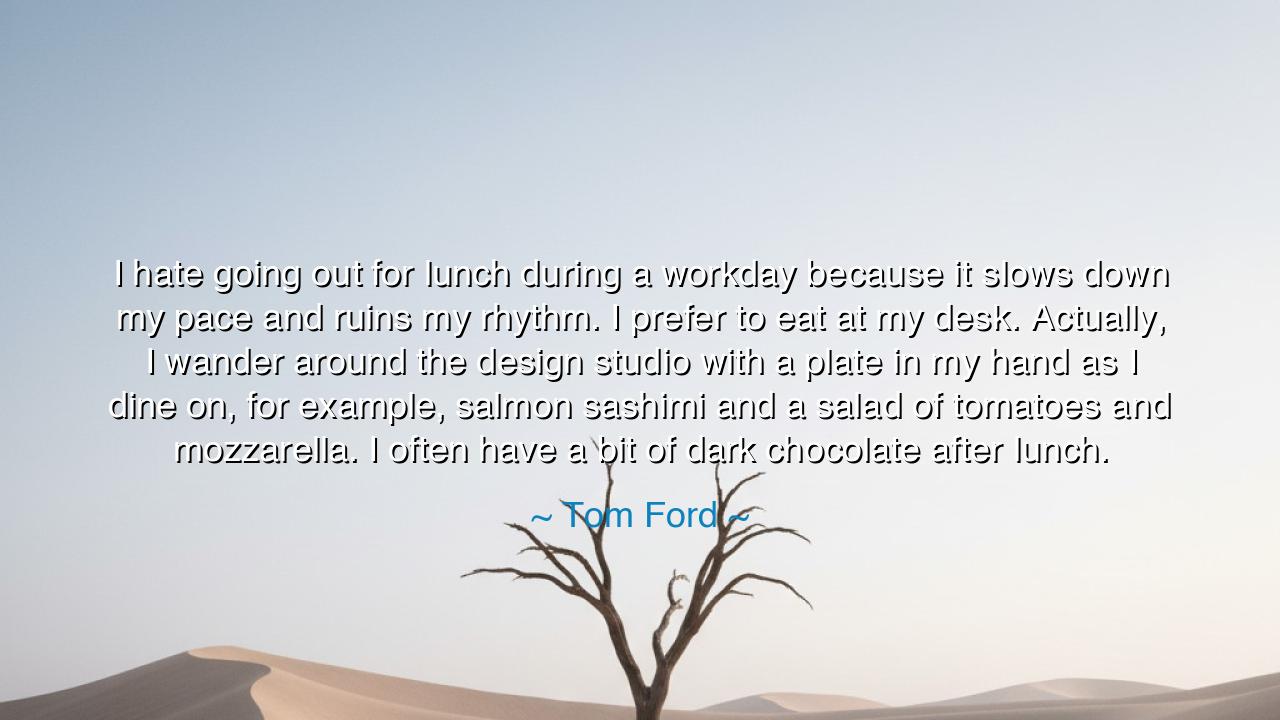
I hate going out for lunch during a workday because it slows down
I hate going out for lunch during a workday because it slows down my pace and ruins my rhythm. I prefer to eat at my desk. Actually, I wander around the design studio with a plate in my hand as I dine on, for example, salmon sashimi and a salad of tomatoes and mozzarella. I often have a bit of dark chocolate after lunch.






In the composed and disciplined voice of a man who has mastered the art of both creation and control, Tom Ford once revealed: “I hate going out for lunch during a workday because it slows down my pace and ruins my rhythm. I prefer to eat at my desk. Actually, I wander around the design studio with a plate in my hand as I dine on, for example, salmon sashimi and a salad of tomatoes and mozzarella. I often have a bit of dark chocolate after lunch.” These words, at first glance, may seem like a simple confession of habit—a glimpse into the routines of a designer at work. Yet to the attentive listener, they reveal far more: a philosophy of focus, a devotion to flow, and the timeless discipline of a craftsman wholly consumed by his purpose.
To understand the origin of this quote, one must first understand the man behind it. Tom Ford, the American designer and filmmaker, rose from modest beginnings to redefine the aesthetics of luxury at Gucci, Yves Saint Laurent, and later his own brand. His days are defined not by chaos, but by an orchestration of precision—a life where every gesture, every thread, every color serves a purpose. When he speaks of avoiding lunch outings because they “ruin his rhythm,” he is speaking as one who knows the fragility of creative momentum. For those who live by the rhythm of inspiration, even the smallest interruption—a conversation, a meal away from the workspace—can break the spell. Ford’s practice of eating at his desk, wandering thoughtfully through the studio, is not mere habit. It is ritual—the ritual of remaining inside the current of creation.
There is a sacredness in rhythm that the ancients themselves understood. The Greek philosopher Pythagoras taught that all of life moves in harmony, that the cosmos itself is music, ordered by rhythm and proportion. To live well, he said, one must align oneself with this natural cadence. Tom Ford, though not speaking in the language of philosophy, reflects this same truth in his devotion to continuity. The rhythm of his workday is his music; his studio is the instrument. To step away, to interrupt the song with idle chatter or leisure, would be to break the harmony that drives his art. Thus, in his quiet rebellion against the mundane tradition of lunch breaks, Ford affirms an ancient principle: that mastery requires unbroken focus and the surrender of comfort to creation.
Yet Ford’s words are not a call to asceticism—they are an ode to intentionality. Notice how he describes his meal: salmon sashimi, tomatoes and mozzarella, and a bit of dark chocolate. Each element is deliberate, refined, and balanced—a reflection of the same aesthetic that defines his designs. Even in nourishment, there is elegance; even in routine, there is taste. His approach to food mirrors his approach to life: quality over quantity, precision over indulgence. In this, Ford teaches that true artistry extends beyond the canvas or the garment—it flows into every moment, every action. A disciplined life is not a life of denial, but one in which every choice is made with purpose and awareness.
History is filled with men and women who lived by this same sacred rhythm. Leonardo da Vinci worked through the night, pausing only for short rests, believing that the muse of invention must never be kept waiting. Nikola Tesla, too, was known to eat sparingly and at fixed times, convinced that his mind must remain unburdened by excess. And even in the arts of governance and war, leaders such as Marcus Aurelius guarded their daily rhythm as a fortress against distraction. All understood that creation and clarity are fragile states—once lost, difficult to regain. Tom Ford’s lunchtime ritual is part of this lineage, a modern echo of ancient discipline, proof that excellence is built not in bursts of inspiration, but in the steady flow of undisturbed labor.
There is also a subtle humility in his statement. By choosing to eat simply and remain within his workspace, Ford rejects the performative leisure of the powerful—the long lunches, the social theater, the endless indulgence that often masquerades as success. He reminds us that greatness is not performed; it is practiced. The wandering of the artist through his studio, plate in hand, is the wandering of the thinker through his own ideas—a moment of quiet communion between body and mind, sustenance and imagination. His dark chocolate, modest and precise, is not excess, but reward—the brief sweetness of satisfaction before the work resumes.
So let this be the teaching drawn from his words: guard your rhythm as you would guard your soul. The world will tempt you with distractions, calling them rest or necessity, but the sacred current of your craft flows only when you remain present within it. Eat, rest, and move with intention; let even your smallest habits serve your highest work. For as Tom Ford shows, discipline is not the enemy of creativity—it is its vessel. When you live each day as a composition of focus, beauty, and rhythm, your life itself becomes a work of art. And in that harmony between the inner pulse and the outer act, you will find not only success, but peace—the peace of one who has found their rhythm and refuses to let the world break it.






AAdministratorAdministrator
Welcome, honored guests. Please leave a comment, we will respond soon